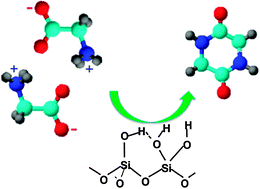A comparative study of the catalysis of peptide bond formation by oxide surfaces
Abstract
It is well-known that

- This article is part of the themed collection: Physical chemistry at the cross-road of advanced oxide materials
* Corresponding authors
a
Laboratoire de Réactivité de Surface (UMR 7197 CNRS), UPMC Univ Paris 6, case courrier 178, 3 R. Galilée, 94200 Ivry-sur-Seine, France
E-mail:
jean-francois.lambert@upmc.fr, maguy.jaber@upmc.fr, thomas.georgelin@upmc.fr
Fax: +33 144276033
Tel: +33 144275519
b
Univ Montpellier 2, Institut Charles Gerhardt - AIME, (UMR 5253 CNRS), case courrier 1502, pl. E. Bataillon, 34095 Montpellier cdx 5, France
E-mail:
lorenzo.stievano@univ-montp2.fr
Fax: +33 467143304
Tel: +33 467143346
It is well-known that

 Please wait while we load your content...
Something went wrong. Try again?
Please wait while we load your content...
Something went wrong. Try again?
J. Lambert, M. Jaber, T. Georgelin and L. Stievano, Phys. Chem. Chem. Phys., 2013, 15, 13371 DOI: 10.1039/C3CP51282G
To request permission to reproduce material from this article, please go to the Copyright Clearance Center request page.
If you are an author contributing to an RSC publication, you do not need to request permission provided correct acknowledgement is given.
If you are the author of this article, you do not need to request permission to reproduce figures and diagrams provided correct acknowledgement is given. If you want to reproduce the whole article in a third-party publication (excluding your thesis/dissertation for which permission is not required) please go to the Copyright Clearance Center request page.
Read more about how to correctly acknowledge RSC content.
 Fetching data from CrossRef.
Fetching data from CrossRef.
This may take some time to load.
Loading related content
